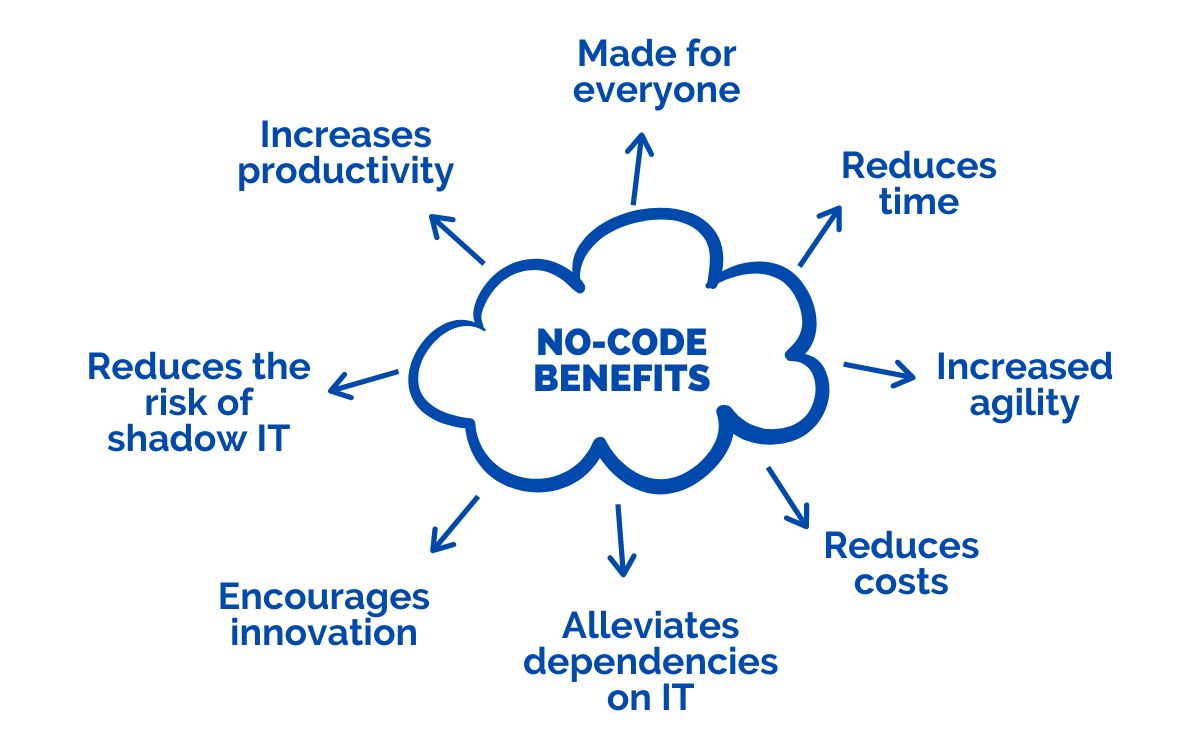
With constant innovations in the technological landscape, there can be confusion about new offerings that are becoming popular. One such new offering is low-code no-code development. To non-technical people, no code can sound like a dream – being able to create applications with no technical knowledge needed. Amazing.
However, no code might also sound too good to be true. This is where the question arises: is no-code viable for your business? Without understanding the basics of no-code development and its advantages and disadvantages, it’ll be difficult to understand whether it can really help you.
In this blog, we’ll break down the basics of low-code no-code (LCNC) development, the benefits of no-code, and the different users that can benefit from this technology.
Also Read: Top 10 No-Code Startups Disrupting Industries
What is Low-Code No-Code (LCNC) Development?
Low-code, no-code development is an environment where individuals and teams can create applications and websites using a visual drag-and-drop builder to reduce hand-coding. These systems can help IT departments cope with requests by allowing citizen developers to create their own applications easily. The low-code market is definitely on the rise, with Gartner predicting that by 2026 developers outside formal IT departments will account for at least 80% which is up from 60% in 2021. This is a new technology that has the power to make everyone’s jobs easier by automating tasks using an LCNC application development platform.
The low-code market is definitely on the rise, with Gartner predicting that by 2026 developers outside formal IT departments will account for at least 80% which is up from 60% in 2021.
Low-code, no-code development involves abstracting and automating parts of the coding process to ensure that even non-technical people can understand and optimally use the platform to create applications and programs. Gartner predicts that by 2024, low-code development will account for more than 65% of application development activity. This surge in popularity of low-code no-code development is due to the numerous benefits and the competitive edge that you can get through developing on LCNC platforms.
Gartner predicts that by 2024, low-code development will account for more than 65% of application development activity.
Also read: LCNC: Is it completely worth the hype?
How are Low-Code and No-Code Different?
Low-code platforms require some coding and are suitable for users with coding skills. On the other hand, No-Code platforms do not require coding and can be used by business users to build applications.
No-code platforms with a limited feature set may not be suitable for building complex applications. However, these platforms are improving by the day, and advanced platforms like Quixy can be used to build simple to complex enterprise-grade applications without writing any code.
Also read: This is Why You Must Use No-Code for IT Operations
What are the Benefits of No-Code?
Is no code viable for you and your business? Taking a look at the different benefits of adopting no-code might help you decide:

1. Made for everyone
No-code development was created with business users and citizen developers in mind, which has led to intuitive interfaces and visual drag-and-drop application builders. No-code application development platforms were created to provide non-technical users with the same functionalities without the need for typing a single line of code.
2. Reduces time
No code allows applications to be developed and tested quickly, thus producing solutions to problems faster.
3. Increased agility
No-code development is highly agile. It is faster to build, maintain, and update applications in this form of development, leading to quicker testing of the application. If there are changes or improvements needed in the application after testing, they can also be done quickly.
4. Reduces costs
No-code development reduces the total cost of application and website development by reducing the overheads and removing the need for full-time developers.
5. Alleviates dependencies on IT
The IT department can often get too burdened with operational issues to focus on strategic ventures. With no-code development, there is a better chance of employees creating and managing applications independently, which can free up time for the IT department to focus on other strategic problems. With 72% of IT leaders saying that project backlogs prevent them from working on strategic projects, no code could really help them.
Also Read: No-Code in the FMCG Industry: A New Era of Innovation
6. Encourages innovation
No-code development can encourage every employee in your business to think creatively and create the perfect solution to solve their particular problem. As the employees and users have the best understanding of their problem, no-code can help them develop an insightful program or application with every functionality they need.
7. Reduces the risk of shadow IT
Shadow IT is the use of IT-related hardware or software without the IT department’s permission or knowledge in a company, and it’s becoming a big issue. If a good no-code platform is introduced, the employees will get a platform to create the applications they need, and the IT department will remain informed about the tools being created. They can provide the necessary governance around the safe use of these tools.
8. Increases productivity
No-code development increases productivity by giving employees the chance to create applications to suit their needs. If employees can create applications that can free up their time from repetitive tasks, this can give them time to focus on more high-level projects. This, in turn, can increase company-wide productivity.
Also read: Top 10 Benefits of No-Code App Development
Can No-Code help with future requirements?
Most Low-code no-code (LCNC) platforms allow for easy maintenance and the ability to extend functionality as and when new requirements roll in. This may include adding new fields, workflow steps, business rules, etc.
Having said that, the no-code platform must have the feature set to handle any complex functionality that the business anticipates, and it’s important to evaluate the platform against such a requirement. There are restrictive platforms that may or may not be able to handle such complex requirements. So customers must watch out.
Also read: The Future of Software is No Code and Low Code Programming
Is No-Code viable for enterprises and entrepreneurs?
No-code is a viable solution for entrepreneurs and enterprises looking for solutions that can provide the above benefits. No-code solutions will be faster to market, easy to maintain, and easier to test than solutions created by a full team of developers. Is no code viable? Yes, and it may have different benefits for different users.
No-code solutions can be perfect for entrepreneurs/business users and enterprises:
- For entrepreneurs/business users:
No code can be helpful for entrepreneurs specifically because they will be able to build and test their business ideas much faster. This method is also very cost-effective, leading to quick solutions at a minimal price. The entrepreneur will also not have to take on the risk of hiring and managing a team of developers working on creating a solution. Through no code, the business user will have the capability to create a program or application that embodies their vision and perfectly fulfills their goals. Apart from building the MVP with no code, entrepreneurs can also use no code to automate their business processes across departments. - For enterprises:
No-code platforms can help small and medium enterprises automate processes across different departments on a single platform. Over a period of time, these enterprises can possibly build custom ERPs on no-code platforms. In large enterprises where an ERP already exists, a no-code platform can help automate processes that the current ERP does not handle and then integrate these new processes with the core ERP.

Also Read: Why Choose Quixy as Your No-Code Application Development Platform?
Conclusion
No-code development is one of the best tools that an entrepreneur or enterprise could use to transform their idea into an actual digital application or program. With its numerous benefits, no-code development is the way to go for faster turnaround time, faster time-to-market, better flexibility, and finding innovative solutions to specific problems. Hopefully, this article helped you answer the question, ‘is no-code viable for me?’.
Quixy is a no-code platform that can help you build bespoke applications using our intuitive visual drag-and-drop builder. Get started with our platform, and experience the ease of automated processes and personalized app building.
Frequently Asked Questions(FAQs)
Q. What are the Benefits of No-Code for Businesses?
No-Code offers benefits such as accelerated development, cost-effectiveness, flexibility, empowerment of non-technical users, quicker innovation, and efficient customization of applications.
Q. Who can benefit from No-Code Solutions?
Various individuals and departments within organizations can benefit from No-Code Solutions. These include professionals from diverse fields such as marketing, sales, human resources, project management, and small businesses without dedicated IT teams. Essentially, anyone seeking to create customized applications, automate workflows, or streamline processes without extensive coding knowledge can find value in No-Code Solutions.
Q. Can No-Code integrate with existing systems?
Yes, No-Code platforms can integrate with existing systems using APIs, webhooks, or connectors, facilitating seamless data exchange and functionality between different software without requiring traditional coding skills.
Q. Is No-Code suitable for businesses needing rapid changes?
Yes, No-Code platforms are ideal for businesses requiring rapid changes. They enable quick modifications to software, applications, or processes without extensive coding, allowing for swift adjustments and updates to meet evolving business needs or market demands.
Q. How to determine if they are suitable candidates for No-Code?
Assess suitability for No-Code by considering factors like task complexity, speed of deployment needed, resource availability, specific use cases, platform flexibility, integration requirements, and security/compliance needs. You can also refer to the solution compatibility checklist. It is a resource that will help you gain valuable insights into the project’s feasibility, helping you make informed decisions.
Login
Please login to comment
0 Comments
Oldest















